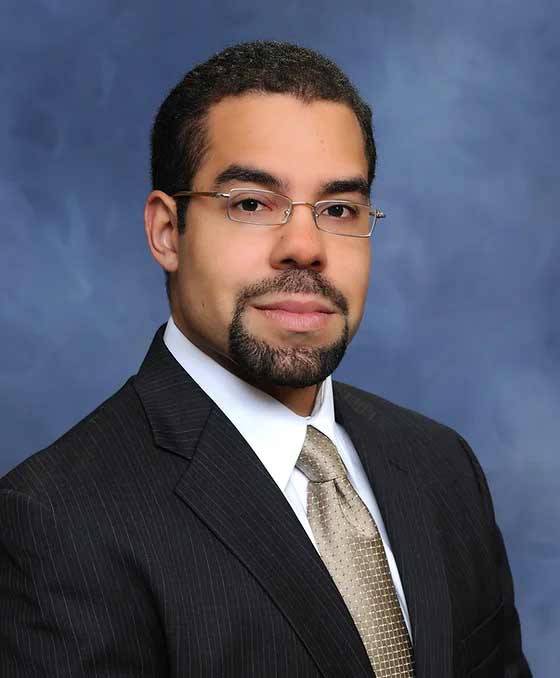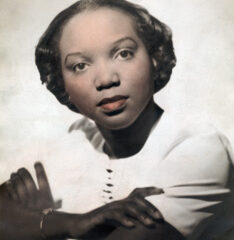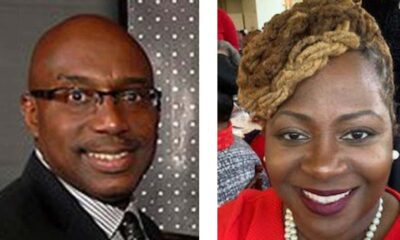Interview
Elsie Richardson: Through a Griot’s Lens

By Bernice Elizabeth Green
March 20, the first day of the 2023 Spring season, comes in with the sonic boom of Global Story Telling Day.
And the global commercial storm of his-story, her-story our-story chatter — especially since the pandemic — threatens to drown us in Everybody’s story. But there is one story that will stay afloat – although even Our Time Press, regretfully, missed the centennial of her birth a little over a year ago on February 24, 2022. Two nouns: Elsie Richardson’s. You may not know her now, but you will. Blondel Pinnock, the new President and CEO of Bedford Stuyvesant Restoration, Corp is poised to correct that oversight in schools, churches, organizations, businesses, and on the streets.
Last week, Wednesday, hours after interviewing Ms. Pinnock about her vision for Restoration, the community landmark that is about to evolve into the next phase of its 60-year life, OTP cleared its intended front page to place a photo of a young Elsie Richardson on the verge of making change. It received attention — our purpose.
For this week’s issue, we present a Q&A with one of Brooklyn’s favored historians and our occasional contributor, Coney Island-raised Brian Purnell, a professor at Bowdoin College in Brunswick, Maine. Favored because he is passionate about Brooklyn’s history and doing work in pursuit of truths through research. He uncovers the heart of the story and then shares it generously. Three days after talking to Pinnock on Women’s History Day, we sent an email to Purnell requesting responses to our questions. His reply was, immediate “Of course.”
A footnote: I interviewed Ms. Pinnock in the same room where I last talked to Ms. Richardson — during a NY Daily News interview I set for her and Restoration’s former CEO Colvin Grannum about 13 years ago. I was geared up to see the differences between the women. I saw parallel paths, coming from the same place, moving towards the same goal. Elsie Richardson’s spirit is alive even now in Restoration.
As I talked to Ms. Pinnock, an all-day workshop for educators was taking place across the bridge at the venerable Museum of the City of New York in Manhattan — dedicated to the life of the late Civil Rights leader and Bedford Stuyvesant community advocate. The session was specifically designed to show how Ms. Richardson’s life should be taught to school-age children in the lower grades.
Mr. Purnell was unabashedly frank in his answers to our brief questions, and we were not far off in our instincts.
First, let’s back up for those who do not know who Elsie Richardson is. The below is excerpted from the Museum of the City of New York’s 100 Stories of Notable New Yorkers archives. It can be found at: www.mcny.org/story/elsie-richardson-investing-bed-stuy
“Civil Rights and Community advocate Elsie Richardson (1922-2012) grew up participating in civil rights campaigns as a teenager and emerged as a courageous fighter for human rights as an adult. As a neighbor and community organizer in the second-largest black community in New York City, Richardson challenged politicians and fought against the economic recession that was devastating her neighborhood of Bedford- Stuyvesant, Brooklyn. Richardson’s legacy lives on to this day, including through the Bedford Stuyvesant Restoration Corporation, an organization she helped found to support the needs of her struggling community that became a model for other communities to follow. Richardson helped form the Central Brooklyn Coordinating Council (CBCC), an umbrella organization for groups seeking to create political pressure to address discrimination and lack of services in the neighborhood.”
Following is the Q&A with Professor Purnell:
OTP Q&A with Brian Purnell on Elsie Richardson
Bernice Elizabeth Green: The Center for Brooklyn History and the New York City Museum appear to have taken a lead in assuring Elsie Richardson’s name is not forgotten. Her 100th birthday came and went quietly on February 24, 2022, without public fanfare. Please define Elsie Richardson’s legacy as you see it and share with our readers if you see that legacy active anywhere in the neighborhood that her “truth to power” moment of 1967 saved.
Scholar Brian Purnell: Elsie Richardson loved her community because she was devoted to her neighbors and family. She possessed strong pride in being a Black person from her upbringing; her parents were followers of Marcus Garvey. Everything she did came from these commitments. She knew the power and potential Black people in Brooklyn possessed. Her legacy comes from the way that Black Brooklynites have maintained and manifested that power in the decades since Elsie Richardson was an organizer and a leader. Anywhere we see Black people in Brooklyn work to develop their communities, their schools, their businesses, and their politics, we see Elsie Richardson’s legacy.
OTP: Would you say Restoration today is an extension of Elsie Richardson and her associate Judge Thomas Russell Jones’s community empowerment missions?
Mr. Purnell: Yes and no. Restoration is a large corporation. The plans for its development as an innovative “tech hub” is part of its long-standing effort and mission to bring jobs and economic development to Central Brooklyn. So, in a way, it is an extension of Elsie Richardson’s mission to develop, improve, and uplift the people and communities of Central Brooklyn. Elsie Richardson’s focus, however, was always on the local level.
Elsie Richardson organized block associations, PTA groups, police precinct councils, community, and civic organizations, voter registration drives, and various other community-minded efforts to get people involved and interacting with their neighbors.
The rise of the new Restoration project looks like the big development projects that, since its inception in 1968, Restoration always wanted to do and had intermittent success in achieving. Restoration teamed with IBM and had a chip manufacturing plant in Central Brooklyn for a while, but that project did not grow into the job-creator that the leadership hoped would emerge.
Elsie Richardson wanted to develop human capital: the power of people to become active citizens in their society. But she sought to do it on a more person-to-person level.
OTP: This month’s Our Time Press recognizes women who appear to embody the Elsie Richardson spirit. In Elsie Richardson’s day, who would she have been compared to: Can you name the women who were/ are like her?
Mr. Purnell: Elsie Richardson always reminded me more of Ella Baker and Fannie Lou Hamer. Like them, she was a powerful and inspirational force who understood leadership as building the capacity in each person to become active and involved in their future and the development of their communities. She was important because she was from the communities she worked with. She was not an outsider.
Elsie Richardson cared about Black children in public schools because she had children in the schools. She cared about housing and safety because she lived in Central Brooklyn. She cared about Black neighborhood associations because she knew they were the key to prosperity for the many, not opportunity for the few. This was the way Ella Baker approached Black activism throughout her long career, starting in the 1930s in Harlem and extending into the 1960s with the Southern movement. This was the strength of Fannie Lou Hamer and her involvement in the Mississippi movement and the Mississippi Freedom Democratic Party.
Elsie Richardson and others in the Central Brooklyn Coordinating Council wanted to bring that kind of people power into the heart of Black Brooklyn’s politics and economic development.
OTP: There is a famous photograph of Richardson looking into the eyes of Shirley Chisholm. It is the same haunting look captured in some portraits of Joan Maynard, Hattie Carthan, artist Onnie Millar and other women “witnesses” to Black Brooklyn history. Some of those photographs appear to speak a million words in just three: “Do not forget.” That’s my perspective, but do you agree that we have taken these women and their work for granted?
Mr. Purnell: Yes, we have taken their work for granted. Joan Maynard is a great example. There wouldn’t be a Weeksville Preservation Society if it weren’t for her. We wouldn’t have the restored houses. We wouldn’t have the history of that important Black community in Brooklyn. We would NEVER have been in a position for the multi-million-dollar investment that brought about the new visitor and education center. That entire community meeting and education space exists because of the incredible years and years of work that Joan Maynard did. Like Richardson, Maynard was always an organizer.
These are people who constantly do the important work of keeping organizations going, inspiring people to get involved, and building projects step by step that become lasting institutions to preserve and protect our community.
Elsie Richardson would want us to remember her by grabbing the torch and keeping that kind of work going. We forget people like Richardson and Maynard when the shiny, big new developments grow on top of the foundations these women laid. Their legacies have less to do with how much development money we bring into a community and more to do with the strength of the people the community sustains and enables.
OTP: Did Elsie Richardson’s peers understand her importance in the history of the borough of Brooklyn, of New York City as a whole, and nationally in Black and Brown history?
Mr. Purnell: Absolutely. One of the reasons we still have the vibrancy and longevity of Black communities in Central Brooklyn was because Elsie Richardson and others helped create the communal infrastructure to weather the terrible social storms of disinvestment, crime, over-policing, and population loss that hit Central Brooklyn in the 1970s-1990s.
If it wasn’t for all the neighborhood improvement, school organizing, and communal development work they did back then, more and more of Central Brooklyn would have been abandoned, devastated, and lost.
About Brian Purnell
A recurring contributor to Our Time Press, Brian Purnell is an Associate Professor of Africana Studies and History at Bowdoin College in Brunswick, Maine, and author of Fighting Jim Crow in the County of Kings: The Congress of Racial Equality in Brooklyn. (University Press in Kentucky, 2013), winner of the New York State Historical Association’s Dixon Ryan Fox Manuscript Prize. In 2019, he was the co-editor (with Jeanne Theoharis) of The Strange Careers of the Jim Crow North: Segregation and Struggle Outside of the South (NYU Press) His scholarship falls within the field of US History with specific concentrations in African American history, urban history, and the Civil Rights and Black Power movements. Born and raised in Coney Island, Brooklyn, much of his work centers around the legacy of racial activism in New York City. Learn more at www.mcny.org/hidden-voices and visit Professor Purnell’s website
www.brianpurnellhistorian.com





